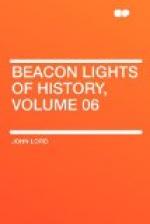It would be useless to attempt to describe those celebrated frescos. Their subjects were taken from the Book of Genesis, with great figures of sibyls and prophets. They are now half-concealed by the accumulated dust and smoke of three hundred years, and can be surveyed only by reclining at full length on the back. We see enough, however, to be impressed with the boldness, the majesty, and the originality of the figures,—their fidelity to nature, the knowledge of anatomy displayed, and the disdain of inferior arts; especially the noble disdain of appealing to false and perverted taste, as if he painted from an exalted ideal in his own mind, which ideal is ever associated with creative power.
It is this creative power which places Michael Angelo at the head of the artists of his great age; and not merely the power to create but the power of realizing the most exalted conceptions. Raphael was doubtless superior to him in grace and beauty, even as Titian afterwards surpassed him in coloring. He delighted, like Dante, in the awful and the terrible. This grandeur of conception was especially seen in his Last Judgment, executed thirty years afterwards, in completion of the Sistine Chapel, the work on which had been suspended at the death of Julius. This vast fresco is nearly seventy feet in height, painted upon the wall at the end of the chapel, as an altar-piece. No subject could have been better adapted to his genius than this—the day of supernal terrors (dies irae, dies illa), when, according to the sentiments of the Middle Ages, the doomed were subjected to every variety of physical suffering, and when this agony of pain, rather than agony of remorse, was expressed in tortured limbs and in faces writhing with demoniacal despair. Such was the variety of tortures which he expressed, showing an unexampled richness in imaginative powers, that people came to see it from the remotest parts of Italy. It made a great sensation, like the appearance of an immortal poem, and was magnificently rewarded; for the painter received a pension of twelve hundred golden crowns a year,—a great sum in that age.
But Michael Angelo did not paint many pieces; he confined himself chiefly to cartoons and designs, which, scattered far and wide, were reproduced by other artists. His most famous cartoon was the Battle of Pisa, the one executed for the ducal palace of Florence, as pendant to one by Leonardo da Vinci, then in the height of his fame. This picture was so remarkable for the accuracy of drawing, and the variety and form of expression, that Raphael came to Florence on purpose to study it; and it was the power of giving boldness and dignity and variety to the human figure, as shown in this painting, which constitutes his great originality and transcendent excellence. The great creations of the painters, in modern times as well as in the ancient, are those which represent the human figure in its ideal excellence,—which of course




